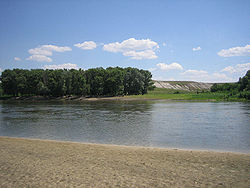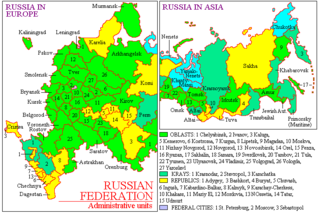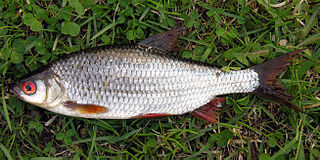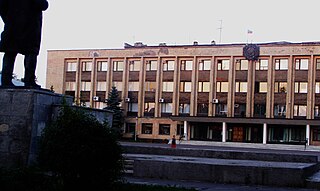
The Kuban River is a river in the Northwest Caucasus region of European Russia. It flows mostly through Krasnodar Krai for 660 kilometres (410 mi) but also in the Karachay–Cherkess Republic, Stavropol Krai and the Republic of Adygea.

Nizhnyaya Tunguska is a river in Siberia, Russia, that flows through the Irkutsk Oblast and the Krasnoyarsk Krai. The river is a right tributary of the Yenisei joining it at Turukhansk. Settlements on the river include Tura, Yukti and Simenga. The ice-free period on the Lower Tunguska starts in mid-June and ends in the first half of October.

The Ardèche is a 125-kilometre (78 mi) long river in south-central France, a right-bank tributary of the River Rhône. Its source is in the Massif Central, near the village of Astet. It flows into the Rhône near Pont-Saint-Esprit, north-west of Orange. The river gives its name to the French department of Ardèche.
Nitsa River is a river in the Sverdlovsk Oblast in Russia. It is a tributary of the Tura. The river commences at the junction of the Neyva and the Rezh, east of the city Alapayevsk and flows firstly in an easterly and then in southeasterly direction. It is 262 kilometres (163 mi) long. However, if the Nitsa and Nev'ya are counted as one, the river is 556 kilometres (345 mi) long. The Nitsa converges with the Tura at East-Nitsinskov.

The Reno is a river of Emilia-Romagna, northern Italy. It is the tenth longest river in Italy and the most important of the region apart from the Po.

The Myosha is a river in Tatarstan, Russian Federation, a right-bank tributary of the Kama River. It flows southward, east of and parallel to the Volga and joins the Kama just before that river joins the Volga. It originates in a forest near the Yatmas-Dusay village of the Kukmorsky District and flows into the Kuybyshev Reservoir west of Narmonka village. It is 204 kilometres (127 mi) long, and its drainage basin covers 4,180 square kilometres (1,610 sq mi). The river is fed by snow and rain, and from November till April it is usually frozen.

The Menzelya is a river in Tatarstan, Russian Federation, a former left-bank tributary of the Ik River, which flows into the Nizhnekamsk Reservoir. It is 147 kilometres (91 mi) long, and its drainage basin covers 2,120 square kilometres (820 sq mi).
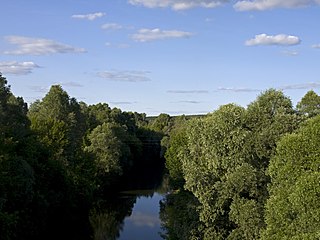
The Toyma is a river in Udmurtia and Tatarstan, Russian Federation, a right-bank tributary of the Kama River. It is 124 kilometres (77 mi) long, of which 84 kilometres (52 mi) are in Tatarstan, and its drainage basin covers 1,446 square kilometres (558 sq mi). It begins in Udmurtia and falls to the Kama near Yelabuga, Tatarstan.
Vorona is a river in the Penza, Tambov, and Voronezh oblasts in Russia. It is a right tributary of the Khopyor River, and is 454 kilometres (282 mi) long, with a drainage basin of 13,200 square kilometres (5,100 sq mi). The average discharge at the mouth is 41.5 cubic metres per second (1,470 cu ft/s). The river is frozen over from the beginning of December to the first half of April.

Savala is a river in the Tambov and Voronezh oblasts of Russia. It is a right tributary of the Khopyor River. The Savala is 285 kilometres (177 mi) long, with a drainage basin of 7,720 square kilometres (2,980 sq mi). It flows over the southern part of the Oka-Don Plain. Its main tributary is the Yelan River. Most of the river's waters are from melting snow. Its average discharge is 20 cubic metres per second (710 cu ft/s). It freezes over in late November, and stays icebound until the spring thaw starts in late March or early April. The town of Zherdevka is along the banks of the Savala.

Konda is a river in the Khanty–Mansia district of Russia. The town of Uray and the Shaimskoye oil field are along the Konda.
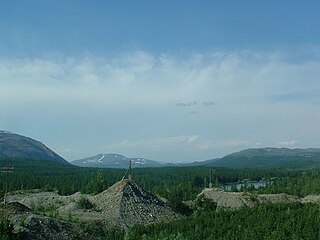
Usa is a river in the northeast corner of European Russia that drains the Polar Urals southwest into the Pechora River. The Polar Urals tend to the northeast and the Usa runs parallel to them. It is in the Komi Republic of Russia and the largest tributary of the Pechora River, which it joins from the right. It is 565 kilometres (351 mi) long, with a drainage basin of 93,600 square kilometres (36,100 sq mi).
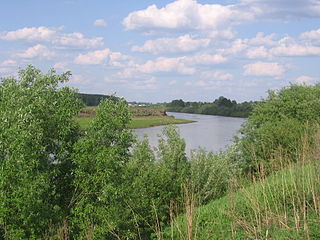
Inya is a river in Kemerovo and Novosibirsk Oblasts of Russia. It is a right tributary of the Ob River. It is 663 kilometres (412 mi) long, with a drainage basin of 17,600 square kilometres (6,800 sq mi).
The Pyshma is a river in Sverdlovsk and Tyumen Oblasts of Russia. It is a tributary of the Tura, and is 603 kilometres (375 mi) long, with a drainage basin of 19,700 square kilometres (7,600 sq mi).

The Bukhtarma River is a river of Kazakhstan. It flows through East Kazakhstan Region, and is a right tributary of the Irtysh. The river is 336 kilometres (209 mi) long, with a basin area of 12,660 square kilometres (4,890 sq mi). The source of the river is in the Southern Altai Mountains. The average water flow rate is 214 cubic metres per second (7,600 cu ft/s).

The Bezdna or Biznä is a river in Tatarstan, Russian Federation, a left-bank tributary of the Volga River, flowing into the Kuybyshev Reservoir near Kuralovo, Spassky District. It is 45 kilometres (28 mi) long, and its drainage basin covers 806 square kilometres (311 sq mi).

The Adyar or Adayar, originating near the Chembarambakkam Lake in Kanchipuram district, is one of the three rivers which winds through Chennai (Madras), Tamil Nadu, India, and joins the Bay of Bengal at the Adyar Estuary. The 42.5-kilometre (26.4 mi) long river contributes to the estuarine ecosystem of Chennai. Despite the high pollution levels, boating and fishing take place in this river. The river collects surplus water from about 200 tanks and lakes, small streams and the rainwater drains in the city, with a combined catchment area of 860 square kilometres (331 sq mi). Most of the waste from the city is drained into this river and the Cooum.
The Redstone River is a large river in the Northwest Territories of Canada. It is about 289 kilometres (180 mi) long. It is a tributary of the Mackenzie River, joining it on the left bank some 100 kilometres (62 mi) north of Wrigley. Draining a rugged and high area of the Mackenzie Mountains, the Redstone watershed is sparsely populated by people but remains an ecological haven for wildlife including moose, caribou, wolves Dall's Sheep and Bears. It is a pristine mountain wilderness.

The Dranse is a French river in the department of Haute-Savoie, that empties into Lake Geneva between Thonon-les-Bains and Évian-les-Bains.

The Punchiná Dam is an embankment dam on the Guatapé River 17 kilometres (11 mi) east of San Carlos in Antioquia Department, Colombia. The dam creates Punchiná Reservoir which is part of the 1,240 megawatts (1,660,000 hp) San Carlos Hydroelectric Power Plant. The power plant was completed in two 620 megawatts (830,000 hp) stages, the first was completed in 1984 and the second in 1987. It is the largest power station in Colombia.
